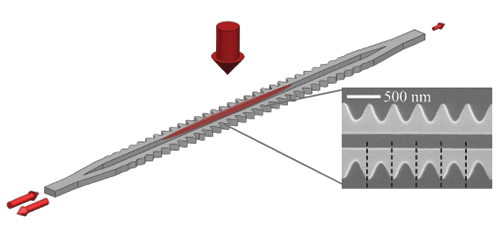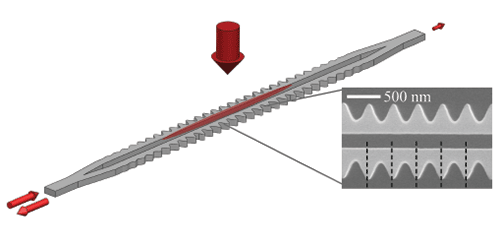Atoms in a Photonic Trap Exhibit Superradiance
At the frontier between atomic physics and nanophotonics, researchers recently managed to trap single atoms around periodic structures called photonic crystal waveguides (PCWs). A new experiment advances this development by trapping multiple atoms near a PCW and inducing coherent emission (“superradiance”) from them. The results imply a strong atom-photon coupling that could be used to create quantum networks or explore many-body systems.
A photonic crystal is a dielectric material containing nanoscopic elements in a periodic arrangement. Certain wavelengths of light propagate through the material, while other wavelengths do not. By carefully designing the periodicity, scientists have exhibited surprising control of light in photonic crystals acting as low-loss waveguides. Recent work has also confined single atoms in close proximity to these PCWs, allowing novel interactions between guided photons and trapped atoms.
Jeff Kimble and his colleagues at the California Institute of Technology in Pasadena have designed a photonic system that traps multiple atoms (as many as three) and monitors their light output. Their waveguide is a flat, 50-micrometer-long slab of silicon nitride, etched into an “alligator” shape with corrugated edges and a thin gap down its spine. The researchers shined laser light from above, forming an atomic trap approximately 200 nanometers above the central gap. The team loaded this trap with cold cesium atoms and then injected pulses of light into the PCW at the “alligator’s head.” The trapped atoms absorbed photons from the waveguide and then preferentially re-emitted photons back into the waveguide. The emission rate was proportional to the number of atoms in the trap—a signature of superradiance. The authors foresee tuning the strong atom-photon coupling to produce long-distance atomic interactions that could, for example, connect a network of atomic qubits.
This research is published in Physical Review Letters.
–Michael Schirber





